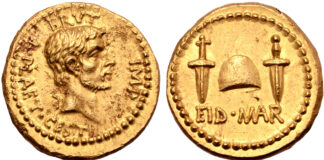The three-day conference “Coinage of the Roman Provinces before Provincial Coinage”, from 23rd to 25th March 2021, co-sponsored by the ANS and the Department of History of the City University of New York, will feature contributions by the foremost scholars in the field. The papers will offer a numismatic and historical overview of each region represented by the coins in the R.B. Witschonke Collection.
It may come as a surprise to learn that as the Romans came to dominate the Mediterranean world, they ruled most of it without imposing their own coinage. Yet this was typical of the Romans’ pragmatic attitude to imperialism, and their tendency to retain any existing forms of effective organization in newly conquered territories. Indeed, it is now generally recognized that we should not talk of “the Roman economy” as a single phenomenon. Instead we should conceive of it as a group of substantially separate regional economies that were yet strongly interconnected through tribute payments and the movements of armies and goods. Although payment in kind played an important role in the Roman world, coinage was still paramount in transactions between the provinces and Rome. To understand those interactions, it is thus important to research the manifold ways in which local coinages converged, at least partly, to create compatible monetary systems across the Roman Empire.
The Roman Provincial Coinage series offers an incomparable tool for the study of the coinages issued in the Roman provinces and client kingdoms from the age of the Civil Wars onward, but does not include the local production in those regions in the preceding decades. The 4,000 coins included in the R. B. Witschonke Collection at the ANS, mainly dating from the second and the first century BCE, provide the prologue to the study of Roman Provincial coinage. Most of the specimens are of great historical and numismatic value, as they illustrate the gradual transition from distinct to compatible monetary systems in the Mediterranean basin. While exhibiting an extraordinary variety in appearance and weight, the coins of the collection tell the tale of a partial convergence toward the Roman monetary system before the inception of the so-called Roman Provincial coinage in the second half of the first century BCE. The ways in which this convergence took place are manifold, spanning from imitations of Roman Republican denarii from Romania and Gaul to the lead tokens of Spain, from Aesillas’ tetradrachms in Macedonia to the Romano-Sicilian coins in Sicily, local coinages and pseudo-mints in Central and Southern Italy. The collection thus offers a unique overview of the diverse ways in which the monetary systems of the Mediterranean basin responded to the Roman conquest in the second and early first century BCE and to the related necessity of interconnectivity.
The conference is free of charge and will be held virtually. A link to participate will be sent to all registrants. To reserve a place, please RSVP by Monday, 22nd March 2021.
For program details, speakers, schedule and to register, visit the website of the American Numismatic Society.
Ursula Kampmann remembered the late Richard B. Witschonke after his death in 2015.




